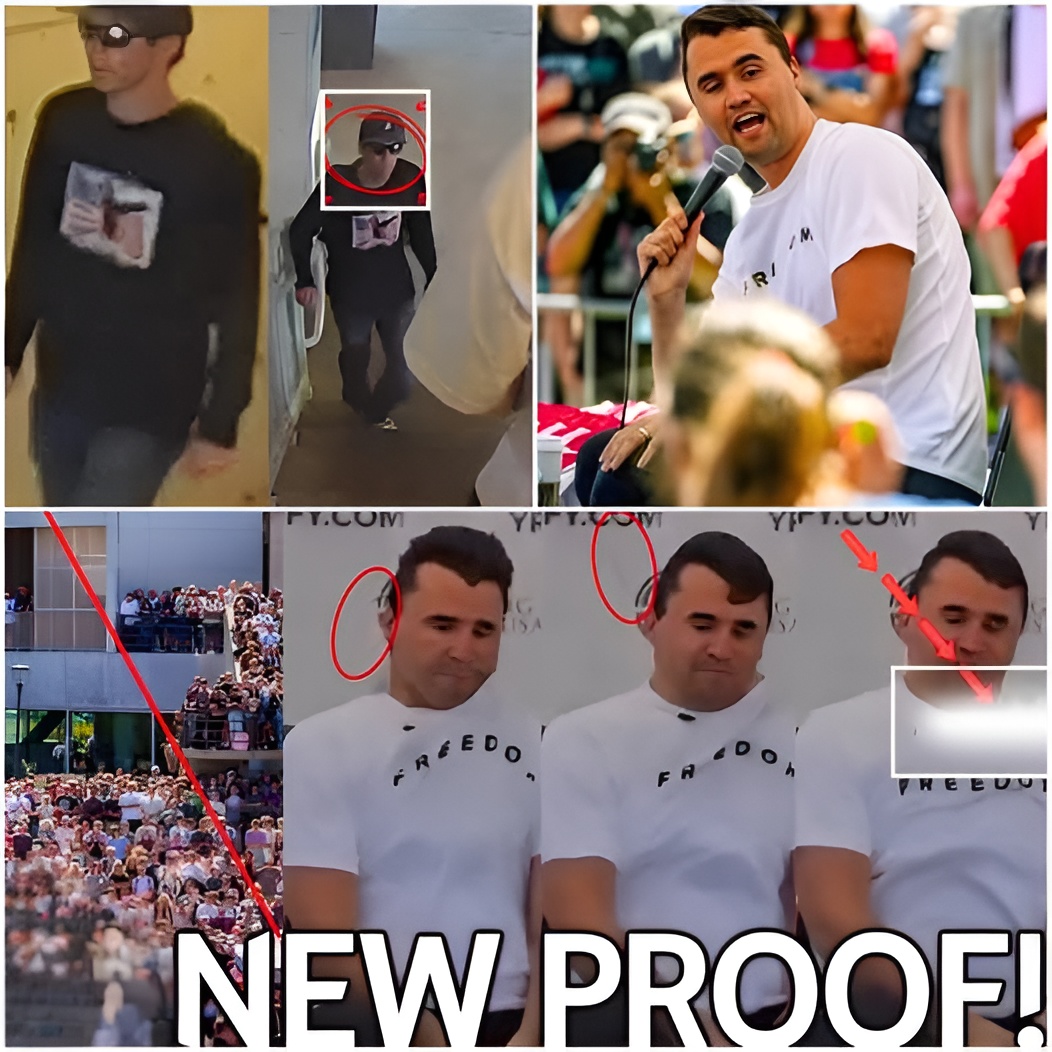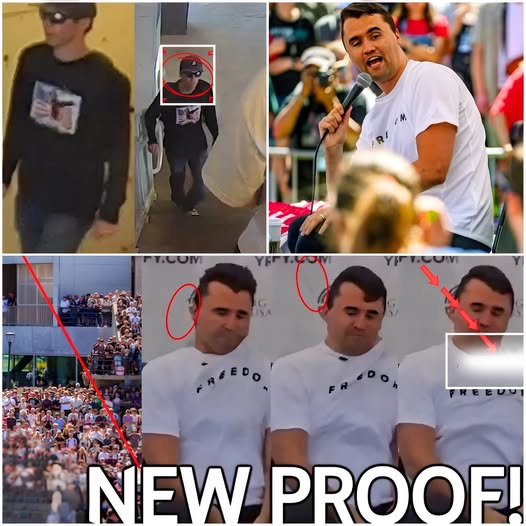When the news first broke about the shooting of Charlie Kirk, the narrative was swift, clean, and tightly wrapped. Investigators said the case was clear. They pointed to Tyler Robinson as the man responsible. The evidence, according to them, lined up neatly. Case closed.
But now — months later — cracks are beginning to appear in that “neat” story. A former U.S. Marine, trained not only in combat but also in battlefield forensics, has released a chilling frame-by-frame breakdown of the incident. What he claims to see in the video is enough to stop even seasoned investigators in their tracks.
And if he’s right, then the entire official version collapses. Because Kirk didn’t fall the way they said he did.
The Marine: Who He Is, and Why His Voice Matters

This is not the voice of a conspiracy theorist behind a computer screen. This is the voice of a man who spent years in combat, who watched bullets tear through the air in Fallujah, who dragged bleeding comrades across desert battlefields.
His name is withheld for security reasons, but his credentials are beyond question. He served two tours overseas. He specialized in battlefield trauma response. He trained in forensic video analysis for counterinsurgency missions. In other words: he’s the last person you’d expect to make wild claims — and the first person you’d want reviewing evidence like this.
When he watched the Kirk footage, he didn’t see what the public was told. He saw something else entirely.
The Video: Slowed Down, Frame by Frame
The original footage, released in fragments to the media, looked ordinary enough at normal speed. A quick movement. A fall. Screams. Panic. And then silence.
But when slowed down — frame by frame — an entirely different picture emerged.
-
The Trajectory: According to the official report, the shot came from a specific angle, fired by Tyler Robinson. But in the Marine’s breakdown, the angle of Kirk’s collapse doesn’t align with that origin point. His body jerks in a direction inconsistent with the supposed line of fire.
-
The Blood Pattern: Years of combat gave this Marine a trained eye for spotting trauma. He noticed the blood spray didn’t match the official version. The mist and spatter indicated a closer, sharper shot — not the distant one investigators described.
-
The Shadow in the Bushes: Perhaps most chilling of all, in one slowed frame, just as Kirk begins to fall, a dark silhouette appears in the background. A figure crouched low, partially hidden by the bushes. Too small to notice at normal speed. Impossible to ignore in forensic slow motion.

“This Isn’t Theory — This Is Physics”
The Marine is careful with his words. He doesn’t shout wild accusations. Instead, he leans on expertise.
“This isn’t theory,” he says in his report. “This is physics. Bodies move a certain way when struck. Blood leaves specific patterns depending on angle, caliber, and distance. I’ve seen it too many times not to recognize it. Kirk didn’t fall the way they said. He couldn’t have.”
His language is cold, clinical, almost surgical. Which makes it all the more terrifying.
The Official Story: Too Clean?
The original investigation was presented as airtight. Robinson was arrested quickly. The media amplified the story. Politicians nodded gravely. Justice, they said, was swift.

But now, with this new analysis, people are beginning to ask: was it too swift? Was it too clean?
Several inconsistencies are now glaring:
-
Witnesses who swore they saw Robinson holding a weapon later admitted they weren’t sure.
-
Surveillance footage was “lost” from a nearby camera.
-
Forensic testing on key pieces of evidence was sealed almost immediately.
Individually, these could be dismissed as mistakes. But together? The Marine says they paint a disturbing picture: a rush to pin it on one man, while ignoring signs that point elsewhere.
The Scapegoat Question: Why Robinson?
If Robinson wasn’t the shooter, why was he targeted so quickly?
The Marine offers a chilling theory: “In every conflict I’ve been in, there’s always someone they can hang the blame on. Someone convenient. Someone who closes the file so higher powers don’t have to answer harder questions.”
Robinson, with his background, his personal disputes, and his presence near the scene, was the perfect scapegoat.
But if he wasn’t the real shooter… who was?
The Bushes: The Forgotten Corner of the Scene
One of the most overlooked parts of the video is the cluster of bushes just behind the crowd. Investigators barely mentioned it. Reporters ignored it.
But the Marine’s analysis brings it front and center. That shadowy figure crouched low, visible in just two frames, changes everything.
-
Was it another shooter?
-
Was it a witness fleeing?
-
Or was it someone deliberately placed there, hidden in plain sight?
The Marine doesn’t say definitively. But his breakdown makes one point clear: that figure doesn’t belong. And yet — investigators never even acknowledged its existence.
Battlefield Forensics Meets Civilian Silence
In war zones, every bullet has a story. Marines are trained to trace them back, to understand trajectory, distance, velocity. Because lives depend on it.
In civilian investigations, however, that level of scrutiny often disappears. Evidence gets boxed up. Reports get written. Questions get brushed aside.
That’s why this Marine’s perspective matters so much. He’s applying battlefield forensics to a civilian case — and the result is devastating for the official story.
The Human Side: A Veteran’s Trauma Resurfaced
For the Marine, this analysis wasn’t just technical. It was personal.
“I thought I’d left it all behind,” he confessed in an interview. “But watching Kirk collapse — the way his body reacted — it brought me right back to the field. The first thing I thought was: ‘That’s not how they said it happened.’ And once you see it, you can’t unsee it.”
His voice broke describing the moment. For him, this isn’t a political fight. It’s about truth. About refusing to let another case be buried under a story that doesn’t add up.
The Ripple Effect: What Happens If He’s Right?
If the Marine’s analysis gains traction, the ripple effects could be enormous.
-
Legal Fallout: Robinson’s conviction could be overturned. New suspects could emerge. Old evidence might be reopened.
-
Political Shockwaves: The case was used as a rallying cry by leaders. If it unravels, so does their credibility.
-
Public Distrust: Already, faith in institutions is fragile. Another collapse of the official story could deepen the divide between citizens and the system that claims to protect them.
Experts Begin to Take Notice
At first, mainstream voices dismissed the Marine’s breakdown as “internet noise.” But as his frame-by-frame analysis spread, forensic experts began quietly weighing in.
Some say his findings are “worth serious review.” Others admit the shadowy figure is “concerning.” No one has yet publicly supported him outright — but no one has debunked him either.
And in silence, there’s often truth.
Tyler Robinson Speaks: “I Was Set Up”
In a recent interview from prison, Robinson reacted to the Marine’s report.
“I knew it,” he said, voice shaking. “I told them I didn’t do it. I told them. But they wouldn’t listen. They needed me to be the guy. And now — now maybe people will finally see I was set up.”
Whether Robinson is innocent or not, the Marine’s analysis gives new weight to his claim.
The Unanswered Questions
Even with the breakdown, the case is far from resolved. The Marine himself admits he doesn’t have all the answers.
But he does leave us with haunting questions:
-
If Kirk didn’t fall the way they said, who fired the real shot?
-
Who was the figure in the bushes?
-
Why were key pieces of evidence rushed, sealed, or ignored?
-
And perhaps most chilling of all: was this tragedy orchestrated from the start?
Conclusion: The Silence After the Shot
At the end of his report, the Marine leaves viewers with one final frame. It shows Kirk collapsing, the crowd frozen, the shadow still visible in the bushes.
“Look closely,” he says. “Don’t take their word for it. Watch the evidence with your own eyes. The truth is right there — hiding in plain sight.”

